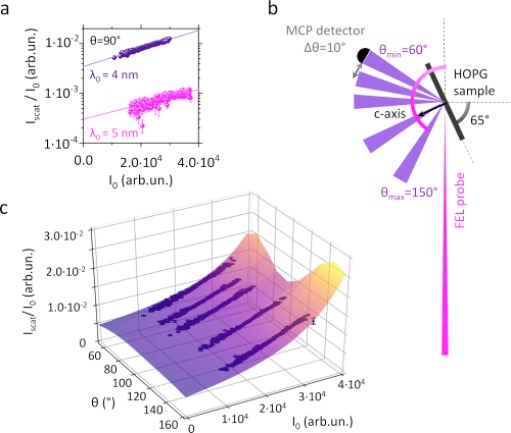Superradiant Thomson scattering from graphite in the extreme ultraviolet on PNAS
ISC researcher Claudia Fasolato coauthored a research paper, recently published on PNAS, based on experimental work carried out at the free electron laser FERMI, at Elettra Synchrotron, in Trieste. See Superradiant Thomson scattering from graphite in the extreme ultraviolet C. Fasolato, E. Stellino, et al., Proceedings of the National Academy of Sciences 121(4), e2221293121 (2024).
Radiation-matter interaction is typically understood through low order perturbation theory, yet this framework falters in exotic environments, such as pulsars, where radiation exists in coherent states with large occupation numbers. Free Electron Lasers (FELs) provide a platform to investigate the interaction of matter with coherent radiation states at the laboratory scale in non-standard experimental conditions. Exploiting the high degree of coherence of FERMI FEL at the TIMEX beamline, a recent experiment from our group has unveiled an intrinsic nonlinear amplification in the extreme ultraviolet (EUV) Thomson scattering cross section from highly oriented pyrolytic graphite (HOPG), unrelated to FEL-induced alterations in the sample state. The exponential growth of the scattering cross section observed on increasing the intensity of the incident radiation reveals the occurrence of a process substantially deviating from linear Thomson scattering (panel a in the Figure).

a) Semi-log plot of the ratio of scattered (Iscatt) to incident (I0) radiation intensity versus I0. Data are shown for incident wavelength λ0=4.08 nm (violet dots) and λ0=4.74 nm (pink dots), vertical incident beam polarization to the scattering plane, and scattering angle θ=90°. Solid lines are single exponential fits to the data. b) Experimental setup at the TIMEX beamline (top view). The FEL beam impinges on the sample tilted by 65°. The scattered radiation is collected by the micro-channel plate detector, with a 10° angular opening, at variable scattering angle θ (60°-150°). c) Trend of the ratio of scattered to incident radiation intensity Iscatt/I0 as a function of I0 and of θ (λ0=4.08 nm, vertical incident beam polarization to the scattering plane). Violet dots: experimental points, surface plot: fitting function.
In line with Dicke’s theory of superradiant emission, the phenomenon can be categorized as superradiant scattering. The scattering indeed involves the creation of low energy, low momentum coherent phonons in the system, which act as collective modes supporting the superradiance, as revealed by measurements at varying the scattering angle (see Figure, panels b and c). The observation can be considered as the first example of superradiant scattering by a crystal and is promoted by a remarkably low number of available channels for the scattering process. That produces the conditions for an increased (n>1) occupation of the final coherent radiation state, which in turn amplifies the scattering cross section. The quantum-mechanical description of the scattering cross section precisely reproduces the measured trends, indicating the way to get useful information on the specimen. The proposed framework sets the basis for designing novel EUV Thomson scattering experiments, opening promising routes for material investigations.


